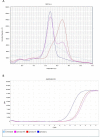Development of molecular assays for the rapid and cost-effective determination of fluoroquinolone, macrolide and lincosamide susceptibility of Mycoplasma synoviae isolates
- PMID: 33125410
- PMCID: PMC7598480
- DOI: 10.1371/journal.pone.0241647
Development of molecular assays for the rapid and cost-effective determination of fluoroquinolone, macrolide and lincosamide susceptibility of Mycoplasma synoviae isolates
Abstract
Mycoplasma synoviae infection occurs worldwide, leading to considerable economic losses in the chicken and turkey industry due to infectious synovitis, respiratory diseases and eggshell apex abnormalities. Control programs against M. synoviae infection are based on eradication, vaccination and medication with antimicrobial agents. Prudent use of antibiotics can be improved greatly by the determination of antibiotic susceptibility prior to the treatment. However, the conventional broth or agar microdilution is very labor-intensive and time-consuming method. Thus, there is an increasing need for rapid antimicrobial susceptibility tests in order to guide antibiotic therapy more effectively. The aim of this study was to develop mismatch amplification mutation assays (MAMAs) to detect resistance-associated mutations in M. synoviae. M. synoviae strains with previously determined minimal inhibitory concentrations (MICs) and whole genomes (n = 92) were used for target selection and assay specification. For the evaluation of the developed assays, 20 clinical samples and an additional 20 M. synoviae isolates derived from these specimens were also included in this study. MIC values of these 20 isolates were determined by broth microdilution method. Five MAMAs were designed to identify elevated MICs of fluoroquinolones, while three MAMAs were developed to detect decreased susceptibility to macrolides and lincomycin. The sensitivity of the MAMA tests varied between 102-104 template copy number/reaction depending on the assay. Clinical samples showed identical genotype calls with the M. synoviae isolates derived from the corresponding specimens in each case. Supporting the results of conventional in vitro sensitivity tests, our approach provides a feasible tool for diagnostics. Rapidity, robustness and cost-effectiveness are powerful advantages of the developed assays. Supporting prudent antibiotic usage instead of empirical treatment, the use of this method can reduce significantly the economic impact of M. synoviae in the poultry industry and decrease bacterial resistance-related public health concerns.
Conflict of interest statement
The authors have declared that no competing interests exist.
Figures



Similar articles
-
Mutations potentially associated with decreased susceptibility to fluoroquinolones, macrolides and lincomycin in Mycoplasma synoviae.Vet Microbiol. 2020 Sep;248:108818. doi: 10.1016/j.vetmic.2020.108818. Epub 2020 Aug 15. Vet Microbiol. 2020. PMID: 32891024
-
Minimal inhibitory concentration of seven antimicrobials to Mycoplasma gallisepticum and Mycoplasma synoviae isolates from six European countries.Avian Pathol. 2021 Apr;50(2):161-173. doi: 10.1080/03079457.2020.1861216. Epub 2021 Jan 20. Avian Pathol. 2021. PMID: 33291970
-
Antibiotic susceptibility profiles of Mycoplasma synoviae strains originating from Central and Eastern Europe.BMC Vet Res. 2017 Nov 17;13(1):342. doi: 10.1186/s12917-017-1266-2. BMC Vet Res. 2017. PMID: 29149886 Free PMC article.
-
Antimicrobial Resistance in Mycoplasma spp.Microbiol Spectr. 2018 Jul;6(4):10.1128/microbiolspec.arba-0030-2018. doi: 10.1128/microbiolspec.ARBA-0030-2018. Microbiol Spectr. 2018. PMID: 30003864 Free PMC article. Review.
-
Mycoplasma pneumoniae: susceptibility and resistance to antibiotics.Future Microbiol. 2011 Apr;6(4):423-31. doi: 10.2217/fmb.11.18. Future Microbiol. 2011. PMID: 21526943 Review.
Cited by
-
Integrating the Human and Animal Sides of Mycoplasmas Resistance to Antimicrobials.Antibiotics (Basel). 2021 Oct 7;10(10):1216. doi: 10.3390/antibiotics10101216. Antibiotics (Basel). 2021. PMID: 34680797 Free PMC article. Review.
-
Two restraining devices in connection to surgical castration with or without local anesthesia: effects on piglet stress.Porcine Health Manag. 2025 Apr 15;11(1):21. doi: 10.1186/s40813-025-00428-7. Porcine Health Manag. 2025. PMID: 40234960 Free PMC article.
References
-
- Ferguson-Noel N, Noormohammadi AH. Mycoplasma synoviae infection In: Swayne DE, editor. Diseases of poultry. 13th ed. Hoboken: John Wiley & Sons Inc; 2013. pp. 900–906.
-
- Hildebrand D. Immunology and prophylaxis associated with the use of a Mycoplasma gallisepticum bacterin in chickens. Clin Vet. 1985; 108: 89–94.
-
- Sulyok KM, Bekő K, Kreizinger Z, Wehmann E, Jerzsele Á, Rónai Z, Turcsányi I, Makrai L, Szeredi L, Jánosi S, Nagy SÁ, Gyuranecz M. Development of molecular methods for the rapid detection of antibiotic susceptibility of Mycoplasma bovis. Vet Microbiol. 2018; 213: 47–57. 10.1016/j.vetmic.2017.11.026 - DOI - PubMed
Publication types
MeSH terms
Substances
LinkOut - more resources
Full Text Sources
Medical
Miscellaneous

